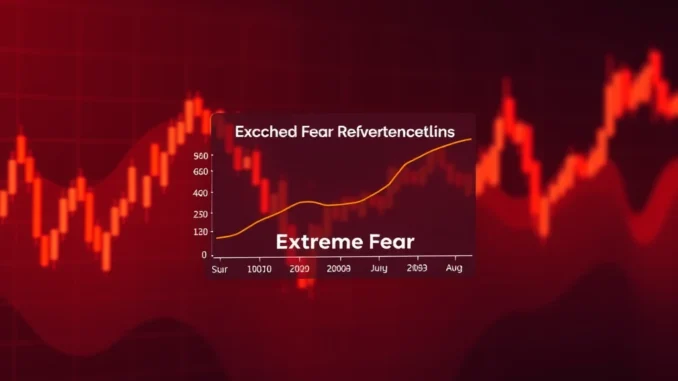
Brace yourselves, crypto enthusiasts! The market sentiment has taken a dramatic turn. The widely-followed Crypto Fear & Greed Index has plummeted, signaling a shift into ‘Extreme Fear‘. Just yesterday, the index stood at 33, comfortably within the ‘Fear’ zone. Today? It’s nosedived a staggering 18 points to a chilling 15. What does this sudden descent mean for your crypto portfolio, and more importantly, what should you do?
Decoding the Crypto Fear & Greed Index: Your Market Sentiment Thermometer
Think of the Crypto Fear & Greed Index as a mood ring for the cryptocurrency market. Created by Alternative.me, this index is not just some arbitrary number; it’s a composite metric designed to gauge the overall sentiment driving the crypto market. It operates on a simple 0-100 scale:
- 0-24: Extreme Fear – Investors are overwhelmingly worried, often indicating a potential buying opportunity.
- 25-49: Fear – Anxious market conditions, suggesting caution.
- 50-74: Greed – Market participants are becoming greedy, potentially signaling an overheated market.
- 75-100: Extreme Greed – Excessive optimism, often a warning sign of a market bubble.
Currently, with the index at 15, we’re deep in ‘Extreme Fear‘ territory. This isn’t just a slight dip; it’s a significant shift that warrants attention.
What Fuels the Fear? Breaking Down the Index Components
The Crypto Fear & Greed Index isn’t based on gut feelings. It’s a data-driven tool that analyzes six key market indicators to provide a comprehensive view of crypto market sentiment. Let’s break down what goes into calculating this crucial index:
- Volatility (25%): Measures the current and maximum drawdowns of Bitcoin, comparing it with the 30-day and 90-day average values. Unusually high volatility often breeds fear.
- Market Momentum/Volume (25%): Compares current market momentum and volume against the 30-day and 90-day averages. High buying volume on positive days indicates greed, while strong selling volume in a negative market signals fear.
- Social Media (15%): Primarily analyzes sentiment on Twitter, particularly hashtag counts and engagement to gauge public opinion and discussion trends around crypto.
- Surveys (15%): Weekly crypto polls are conducted to understand investor sentiment. While currently paused, historical survey data remains a factor in the index calculation.
- Bitcoin Dominance (10%): Measures Bitcoin’s share of the total crypto market cap. Increased Bitcoin dominance can sometimes indicate fear as investors may be moving away from riskier altcoins towards Bitcoin as a perceived safer haven.
- Google Trends (10%): Analyzes Google Trends data for Bitcoin-related search queries. Spikes in searches like “Bitcoin manipulation” often correlate with market fear.
Why Does Extreme Fear Matter to You? Actionable Insights for Crypto Investors
The shift to ‘Extreme Fear‘ isn’t just a headline; it has real implications for crypto investors. Here’s why you should pay attention and what you can potentially do:
- Potential Buying Opportunity?: Historically, periods of ‘Extreme Fear‘ have often presented themselves as opportune moments to buy. When fear is rampant, asset prices can be pushed below their intrinsic value, creating a “buy the dip” scenario for savvy investors.
- Market Correction or Deeper Downtrend?: While ‘Extreme Fear‘ can signal a buying opportunity, it’s crucial to assess the broader market context. Is this a temporary correction, or are there deeper macroeconomic factors at play suggesting a prolonged downturn? Further research and due diligence are essential.
- Risk Management is Key: In times of heightened fear and market volatility, risk management becomes paramount. Consider re-evaluating your portfolio allocation, setting stop-loss orders, and ensuring you’re not overexposed to high-risk assets.
- Stay Informed, Avoid Panic: News like the Crypto Fear & Greed Index dropping to ‘Extreme Fear‘ can be unsettling. However, it’s vital to stay informed from reliable sources and avoid making impulsive decisions based on fear. Understand the data, analyze the market, and make informed choices aligned with your investment strategy.
Bitcoin’s Role in the Fear Factor: What’s Next for the Leading Cryptocurrency?
Bitcoin, as the flagship cryptocurrency, often leads market sentiment. When the Crypto Fear & Greed Index indicates ‘Extreme Fear‘, it’s often reflected in Bitcoin‘s price action. The recent drop in the index coincides with increased market uncertainty, potentially influenced by global economic factors, regulatory concerns, or simply market cycles.
Will Bitcoin lead the market out of this ‘Extreme Fear‘ zone? Or will the fear persist, potentially driving prices lower? Monitoring Bitcoin‘s price movements, along with other indicators, will be crucial in the coming days and weeks. Keep an eye on key support and resistance levels, trading volumes, and broader market news to gauge the potential direction.
Navigating Crypto Market Volatility: Staying Calm Amidst the Fear
The cryptocurrency market is known for its market volatility, and periods of ‘Extreme Fear‘ are part of this cycle. While it can be unnerving to see such dramatic shifts in sentiment, remember that market cycles are natural. Understanding tools like the Crypto Fear & Greed Index helps you to:
- Objectively Assess Market Sentiment: Move beyond emotional reactions and look at data-driven insights.
- Identify Potential Opportunities: ‘Extreme Fear‘ can create buying opportunities for long-term investors.
- Manage Risk Effectively: Understand when to be cautious and adjust your investment strategy accordingly.
In conclusion, the Crypto Fear & Greed Index plummeting to 15 and entering ‘Extreme Fear‘ is a significant market signal. While it may feel unsettling, it’s crucial to understand what this index represents, analyze the underlying factors, and make informed decisions. Stay calm, stay informed, and navigate this period of crypto market sentiment with a strategic approach.



